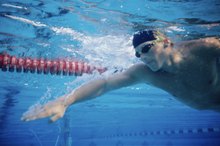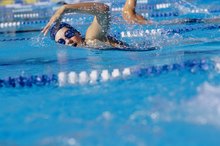Normal Body Fat Percentage of Women Swimmers
Most female athletes carry between 8 and 15 percent fat, but swimmers usually have a bit more -- between 14 and 24 percent. While any body fat percentage below 30 is perfectly healthy for a woman, it's expected that competitive athletes be among the leanest and sleekest people around. Swimming has different demands than land-based sports, though. Female swimmers who have a little extra padding are actually at an advantage in competition.
Swimmers Benefit From Buoyancy
Leanness is a benefit for women who participate in land-based sports. When facing gravity, fat only weighs you down and doesn't offer any strength or power to propel you forward. This is why female runners tend to have between 10 and 15 percent fat; they want to carry the minimum amount of weight possible. A leaner body also looks more defined and taut, so bodybuilders and fitness competitors also strive for similarly low levels.
When a sport is performed in the water, however, fat provides more buoyancy than muscle mass. This allows swimmers who have a higher percentage of fat to float more readily in the water. Instead of using energy to stay horizontal, the athlete can focus on strokes and kicks to pull forward.
Swimmers with a lot of muscle mass may have more strength, but it's wasted on the mechanics of staying high in the water. Multi-sport athletes, particularly triathletes, tend to err on the side of being lean because the majority of their competition is spent cycling and running -- sports that benefit from a lower body fat level.
A Woman's Advantage in Fat Distribution
Does Losing Body Weight Make Me Swim Faster?
Learn More
Women tend to carry excess fat in the hips, thighs and buttocks. Hormones associated with childbirth and breastfeeding drive this storage to support a fetus and newborn. This means the lower half of female swimmers float more readily, and this reduces drag, according to Dr. David Costill, writing for U.S. Masters Swimming. A more buoyant back end greatly reduces the amount of energy -- in terms of calories per pound of weight -- a woman uses to swim at the same speed compared to a thin man.
If male swimmers attempted to become more buoyant by adding fat, it would backfire, however. Men tend to gain weight in the belly, which would make their upper bodies float, but their legs sink, which would increase drag and slow them down.
Maintain a Healthy Body Fat Percentage for a Swimmer
Although a woman swimmer benefits from carrying a little more fat than her runner friends, she shouldn't seek to gain excessive levels. If you have a body fat level that exceeds 30 percent, you're considered overweight and at increased risk of certain health conditions such as type 2 diabetes and heart disease. If you're interested in getting your body fat percentage measured, methods include bioelectrical impedance scales, skinfold calipers and clinical Dexa X-ray scans or hydrostatic weighing.
Carrying too much fat may ultimately slow you down in the water, too. Even though you'll be more buoyant, it'll take more effort to pull your weight through the water. You'll also increase drag around bulging areas of your body, including your abdomen and buttocks, slowing your swimming speed considerably. A torpedo shape is most efficient at gliding through the water.
Reaching a Desirable Body Fat for a Swimmer
How Much Does Body Weight Affect Your Cycling Speed?
Learn More
A calorie deficit can help you drop fat if you and your coach believe it could benefit your performance and health. Try to use 500 to 1,000 calories more per day than you consume. An online calorie calculator or sports dietitian can help you determine your daily calorie burn by taking into consideration your age, size and activity level.
Trimming portion sizes and avoiding sweets and processed snacks help you cut calories. Meals and snacks should be centered around lean proteins, whole grains, vegetables, fruits and low-fat dairy. As a competitive swimmer, you most likely already have a structured exercise plan that includes land-based strength training. If not, talk to your coach about adding appropriate weight work to enhance your body's composition and performance.
Related Articles
References
Writer Bio
Andrea Cespedes is a professionally trained chef who has focused studies in nutrition. With more than 20 years of experience in the fitness industry, she coaches cycling and running and teaches Pilates and yoga. She is an American Council on Exercise-certified personal trainer, RYT-200 and has degrees from Princeton and Columbia University.









